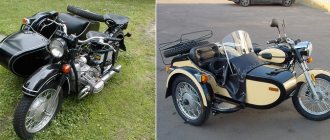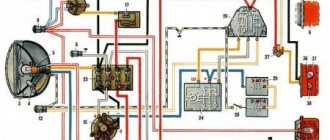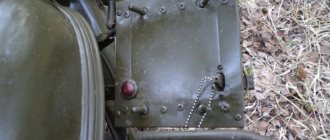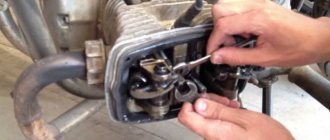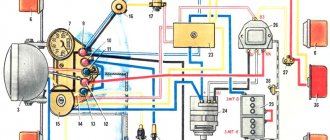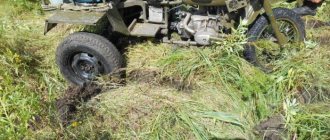IMZ-8.103–10 is the most popular model of the Irbit Motor Plant. Produced since 1986. From 1988 to 1993, more than 100 thousand of these machines rolled off the assembly line annually, and in total more than 830 thousand were produced. The main design feature is the presence of a reverse gear, which is so necessary for a heavy motorcycle with a sidecar. Having inherited from the previous one, IMZ-8.103–30, units that had proven themselves quite well in many years of operation, it also received a number of new ones. First of all, let's name the K-63U carburetors. They made it possible to reduce gasoline consumption at speeds of 40–70 km/h by 0.6–0.4 l/100 km. The control fuel consumption of the new car (with a full load, at a constant speed of 78 km/h) is no more than 7.8 l/100 km versus 8 l/100 km for the previous model. The level of toxic emissions has been reduced, which ensures that the motorcycle complies with the new standard for this indicator. To reduce noise, the modernized Ural is equipped with a new air filter with a resonator - an additional chamber that effectively dampens intake noise (as is known, this is one of the important components of the overall noise level). The filter housing and its other parts are made of plastic, which has better noise absorption properties than metal. Thanks to the gearbox using reverse gear, maneuverability and, to some extent, cross-country ability have been significantly improved. We hope that the owners of the Urals will also appreciate the fact that the new box is interchangeable with the old one, both as an assembly and in many parts. When installing a new box on the Urals of earlier releases, it is also not necessary to change the length of the driveshaft. A new instrument panel with four warning lamps meets modern safety requirements: battery low (red light filter), high beam (blue), turn indicators (yellow) and neutral position in the gearbox (green). And one more improvement that we consider significant, although owners are unlikely to notice it: the motorcycle has become 5 kg lighter. In addition to the air filter, other design changes played a role in this.
A. KHALTURIN - Deputy Chief Designer of IMZ.
Review of the Ural motorcycle IMZ-8.103–10 “New familiar URAL”: It just so happened that with all the popularity of the heavy motorcycles of the Irbit plant, not one of them has yet come to us for editorial testing. Meanwhile, readers have repeatedly persistently recommended that we get to know them better. And last spring we finally received a new Ural. However, first there was a trip to the factory. It was January. But when one of us got off the train, I was amazed to see about a dozen motorcycles on the station square. The frost is about 30 degrees, the wind is windy - and people ride motorcycles as if nothing had happened! In Moscow, and in other large cities in the European part of the country, you won’t see this in winter. After three days in Irbit, the motorcycle became familiar on the streets and became familiar to the eye. The Irbit motorcycle plant, which grew out of nowhere during the war from an evacuated Moscow enterprise, now appears to be a fairly large company, with a capacity that allows it to produce up to 130 thousand cars per year. However, the equipment here is outdated, and the possibilities for modernizing production are limited. And therefore, any improvement in design is associated with enormous difficulties. Factory workers explain the rare replacement of models and the low quality of products with the same reasons.
The latest model of the Irbitsky IMZ-8.103–10 (at that time it was 1989). The factory provided this motorcycle to us for consumer testing. The first engine start is always an exciting moment. After filling the carburetor float chambers with fuel, one press on the kickstarter pedal was enough for the Ural to come to life. The rather quiet, stable operation of the engine at low speeds frankly pleased us. The car turned out to be dynamic, easy to use, and very high-torque. By the end of the 1988 summer season, a beautiful series of numbers appeared on the speedometer - 10 thousand kilometers. Some of them are the streets of Moscow. But a good half fell on southern highways, including the mountain roads of the Caucasus. During this time, we got used to the car and positively assessed some of its qualities, disagreeing with others - in a word, we can talk more scrupulously about the details.
"Ural" IMZ-8.103–10, of course, compares favorably with its predecessor IMZ-8.103–30. The external differences are immediately noticeable: a chrome-plated fender above the front wheel, cast aluminum alloy hubs with straight spokes of the same length (the complete transition to these hubs will only take place in 1995). The last circumstance is especially important: there is no need to tighten the spokes after 2–3 thousand kilometers. In addition, short spokes provide the wheel with high constant rigidity, and the absence of bending at their heads eliminates stress concentration in these places. In addition, the old knitting needles worked in shear at the heads (that’s why they tore!), while straight knitting needles worked in tension along the entire length. Tires with a new tread pattern grip the road well, which is especially noticeable when making a left turn.
The two-cam front brake easily locks the wheel on any road surface, but the nonlinear relationship between the force on the lever and the developed braking torque requires some getting used to. True, this drawback is inherent in all drum brakes and is not so significant. The motorcycle is equipped with a speedometer, complemented by a daily mileage counter, and a warning lamp unit. At the same time, such important parameters of engine operation as oil pressure, temperature and speed were ignored. It's a pity. The presence of indicator lamps for these parameters and a tachometer in the block of warning lamps would have a positive effect on the service life.
A good windshield can at a stretch be called a fairing (was an option). It is beautiful, comfortable, and protects the driver well from wind and dust, but only if the stroller does not have glass (Also an option). This glass creates such a strong reflected air flow that driving at speeds above 60 km/h is tiring and all the advantages of the fairing are lost. The front wheel fork is very stiff, and an extra 40–50 mm of travel could significantly improve the comfort of the motorcycle. The comfortable steering wheel does not cause fatigue even after many hours of continuous driving, but vibration and impacts of the wheel on uneven roads are not dampened by anything. Here, apparently, it would make sense to attach the steering wheel through rubber bushings, as is done, for example, on IZH motorcycles.
The throttle is quite hard and my right hand gets tired by the end of the day. However, few people drive for such a long time and continuously, and this feature can be easily tolerated. The new fuel tank (not widely installed on production motorcycles), unified with the Dnepr motorcycles, gives the appearance of the motorcycle some new touches, it is convenient, has a slightly larger (22 liters) capacity and a tool box in the upper part. The suspension of the rear wheel and sidecar works satisfactorily, but still for those roads where “Urals” are mainly used, springs with a progressive characteristic and a slightly greater travel of the rear wheel are needed.
A few words about the power unit. An air-cooled engine operates under intense thermal conditions, and ensuring good cooling is of paramount importance. The new sump now has cooling fins and an increased capacity for engine oil to 3 liters (versus 1.8 liters), which to a certain extent reduces the likelihood of overheating. But the wind shields protecting the driver’s legs had to be trimmed somewhat at the bottom, otherwise the cylinder heads would end up in the aerodynamic shadow zone. This is especially true for the left cylinder, since it is in worse conditions than the right one. This is due to the presence of a stroller, the side of which plays the role of a deflector, increasing the air flow to the right cylinder.
K-63 carburetors are installed on cylinder heads without heat-insulating spacers and screens. They get so hot that you can’t touch them with your hand, which means some of the gasoline is wasted evaporating from the float chambers. By the way, about gasoline consumption. A motorcycle with a driver and a passenger in a sidecar plus 50 kg of cargo at a speed of 80 km/h consumes 9.5 liters per 100 kilometers. Our motorcycle's oil consumption was about 1% of gasoline consumption, which is generally acceptable. High fuel consumption is inherent in all motorcycles with sidecars, and this is explained primarily by extremely low aerodynamic qualities. At speeds of 80 km/h and above, it feels like you have to push a tight wall of air in front of you.
The gearbox finally has a reverse gear. Now, when parking the motorcycle, there is no need to figure out how to get out. After all, pushing almost 400 kg alone is not much fun. And maneuverability with reverse gear has increased significantly. But controlling the box is still extremely inconvenient. The gear shift lever is located so that the transition from low to high is carried out by pressing the pedal with the heel, for which the foot has to be removed from the footrest and turned out. Of course, you can get used to this too. But aren't we getting used to too much? Why is this unnecessary inconvenience necessary, if it is not at all difficult to make the pedal smooth, like, for example, IZH, or one-sided, like YAVA or Voskhod. The new contactless ignition system works reliably in all modes, there are no comments (will be installed optionally in 1990).
In general, IMZ-8.103–10 showed itself at this stage of testing as a simple and reliable motorcycle that requires minimal maintenance. We, however, really did not like two circumstances: strong vibrations and increased noise of the generator drive that stands out from the general background. It seems that the noise from the mufflers might not be so strong. By the way, a little more about “getting used to.” In October last year, the editorial office was visited by a group of motorcycle tourists from Germany. They arrived in powerful BMWs, Harleys and Hondas, developing up to 80–90 hp. With. And when we started our cars at the entrance, it turned out that the Ural with its exhaust covered the general noise, but it didn’t seem loud to us at all. This is how useful it can be to look at the familiar with different eyes! Magazine "Behind the Wheel" 1989
In 1994, the demand for Ural motorcycles fell sharply, as a result, a lot of unsold equipment accumulated in the plant’s warehouses, which the plant used to pay suppliers so as not to stop production completely. After 1994, the URAL 8.103–10 model was produced in smaller and smaller volumes every year, in parallel with how demand on the domestic market fell to almost zero. However, the model was relatively readily in demand for export. For the export market, the model was designated as “Ural Classic”. Gradually, the differences between the export and domestic versions became very significant, since in the domestic market the main criterion was low price, so the model was exported in a richer color, with more chrome, disc brakes, carburetors and a different front fork. The model was produced exclusively with 650 cc engines and was withdrawn from the company’s product range due to the transition of the entire Ural product range to 750 cc engines in 2003. The model with a 750 cc engine was named “Ural Troika”, which also had a richer version “Ural Troika Lux”.
Purchase of IMZ 8.103.10
Hello everyone, I especially want to say hello to all fans of Soviet boxer technology. Once upon a time, or rather since I was 9 years old, I first sat on a motorcycle (at that time it was my father’s old IZH Jupiter 4) and realized that a motorcycle was cool. As time passed, I rode a lot of things, but closer to my majority, I bought my first URAL , which everyone liked, but while I was serving in the armed forces, the motorcycle was sold. After serving for two more years, I returned home and started a family, but my passion for motorcycles did not fade. I work on a long-distance truck, there’s plenty of time to think on the road on autumn evenings - so I came up with something... and this is what I came up with. Why not buy some kind of half-dead URAL, most importantly with re-issued documents. I started looking at advertisements in different areas through which my path passed and found an option that I thought was interesting. For 10,000 rubles , a motorcycle was sold not running, without a sidecar, with some shortcomings, a homemade welded side stand, BUT with a solid seat, on wheels with a cast hub (Tourist) and of course, most importantly, WITH DOCUMENTS!! . In the photographs taken three years ago the motorcycle looked pretty good, but the seller warned that these were old photos, although in principle the external condition was not so important to me:
I called, talked to the seller and met. I didn’t really look at the motorcycle for a long time, I just looked to make sure it wasn’t crooked or askew, I removed the tank, I checked that the frame wasn’t humped (I met one like that once when I was inspecting a friend’s motorcycle) and, of course, I checked the documents. We load the motorcycle, tie it up and hit the road. That's the actual purchase
I tied it tightly enough since the ride to home was exactly 1000 km . The seller also presented me with two gearboxes from Dnepr , which were disassembled, but I love hardware and didn’t refuse.
The mileage at the time of purchase was 22,512 km , my favorite mileage, because as practice shows, very often motorcycles with low mileage are actually problematic, which is why they sat there all the time while others were working. Motorcycles with high mileage (from 30,000 km and more) are usually tired and worked in villages, and often with trailers, which is also not so good for the engine, but mileage from 15,000 to 30,000 km is just that. Not tortured by life and at the same time it is clear that they worked in the time range when it was relevant (from the moment of purchase until approximately 1998 - 2000 )
For the last three years, as the owner said, the motorcycle was standing on the street in the heat and cold, not even covered with anything, so all the rubber bands and plastic parts cracked and became unusable, and the metal, including even the chrome parts, became covered with rust.
The wheels, as I wrote above, had a cast hub (just the way I like them) this is a more recent version of the wheels that received the nickname “ Tourist ” because they were installed on URAL TOURIST 8.103.40 Daisies ” suffered from, which appropriate hub shape. The hub of the tourist rims is aluminum, so when braking, the heat transfer is of course better, and if the brake overheats, the paint will not burn off the hub, as this often happens on daisies, and also on daisies, short spokes often tear under load (especially for those who like to ride with the stroller lifted up or spin the pennies).
True, it could not have happened without customizing the previous owner, namely giving a more classy look to the not-so-rusty muffler (it still has a long life to live, but...)
The motorcycle is from 1993 , which means it has reverse gear. Of course this is a huge plus, but the fact that it doesn’t work is of course a minus, but the fact that the seller didn’t deceive me is a plus again, so we have two pluses against one minus and that’s not even bad))
So little by little I made it home, and my friend and I unloaded my purchase.
The next day I decided to rinse the horse to see, as they say, the full scale of the disaster, the bandage is tough, of course...
The speedometer even fogged up from shame
Something like that. Of course, I was more than pleased with the purchase, I will put it in order. The plans are to buy a stroller, completely repaint it, bring the engine to excellent condition, and maybe even go on some kind of trip.
